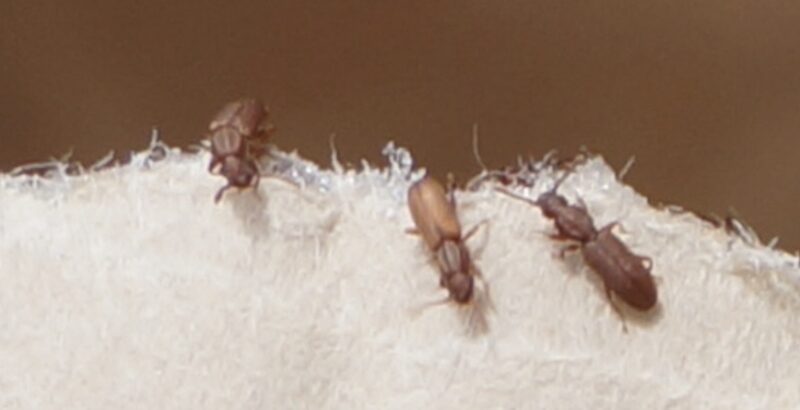Amidst the complex landscape of food processing, the intrusion of pests can pose a serious threat to product quality and safety. Recently, a team member from Sprague Pest Solutions encountered a concerning scene during a visit to a client. The bags of rolled wheat flakes were teeming with grain beetles, illuminating the urgent need for robust pest control in such environments.
During this insightful encounter, a key principle echoed through the conversation: the more one knows, the more one sees. Often, pests are not newcomers but rather unnoticed occupants, underscoring the necessity of education and vigilant observation. Detailed exploration into the identities of these persistent pests—merchant grain beetles and sawtooth green beetles—revealed crucial insights.
Merchant Grain Beetles
Merchant grain beetles, belonging to the Oryzaephilus mercator species, are known for their preference for fruits and seeds, making them more commonly found among stored food products. These beetles are identifiable by their relatively smaller tubercles behind the eyes, distinguishing them from sawtooth grain beetles.
When it comes to their life cycle, female merchant grain beetles can lay approximately 300 to 400 eggs over their lifespan, with an average of 6 to 10 eggs daily. Their developmental period extends a bit longer than that of sawtooth grain beetles, averaging a few days more. Despite their similar biology, merchant grain beetles are adept at developing in lower temperatures, thriving in environments a few degrees centigrade lower than what sawtooth grain beetles can endure.
Sawtooth Grain Beetles
On the other hand, sawtooth grain beetles (Oryzaephilus surinamensis) display a preference for cereals and processed foods. These beetles can be identified by their larger tubercles and the “saw like” projections along the edge of their thorax, making them easily distinguishable from merchant grain beetles. They are small, flat beetles about 3mm long and their developmental period averages between 28 to 32 days, relatively shorter compared to merchant grain beetles.
Both merchant and sawtooth grain beetles are scavengers, unable to penetrate whole grains. They survive by feeding on broken grains’ fragments and detritus. However, they exhibit exceptional climbing abilities, which enable them to ascend smooth surfaces, impacting trapping efficacy and entry points in various environments.
Common Traits
Despite their differences, both species share similarities in their infestation behaviors. They tend to thrive in low-moisture environments and have a remarkable tolerance for extremely dry conditions. This adaptability allows them to threaten a wide array of products, from coarse milled grains like rolled oats to dried fruits and nuts. Surprisingly, both species are attracted to chocolate residues, making food processing facilities potential hotspots for infestations.
Preventative Measures
Understanding the nuances and differences between merchant grain beetles and sawtooth grain beetles is crucial for effective pest control strategies. At Sprague, we understand that defending against these potential infestations requires not just knowledge but a proactive approach.
- Thorough Inspection and Monitoring: Our teams conduct regular inspection of incoming raw materials, storage area, and processing equipment to find any beetles that could cause damage to your food product. We utilize monitoring tools to detect early signs of activity.
- Proper Storage and Packaging: Stored grain and processed foods in airtight containers or packaging to minimize exposure to external contaminates. Seal any cracks or crevices in storage areas to prevent beetle access.
- Sanitation Practices: Maintain a high standard of cleanliness by promptly removing spilled or broken grains and food residues. Regular cleaning and sanitation help eliminate potential food sources.
- Regular Maintenance and Upkeep: Conduct routine inspects of equipment and storage areas to address any potential entry points or conducive conditions.
By staying vigilant and informed about these commonly overlooked pests, Sprague can help you create a pest-free environment and prevent product loss. At Sprague, we aim not just to control pests but to be your dedicated partner in ensuring a pest-free future for your business or commercial space. Join us on this journey towards a pest-free environment.

